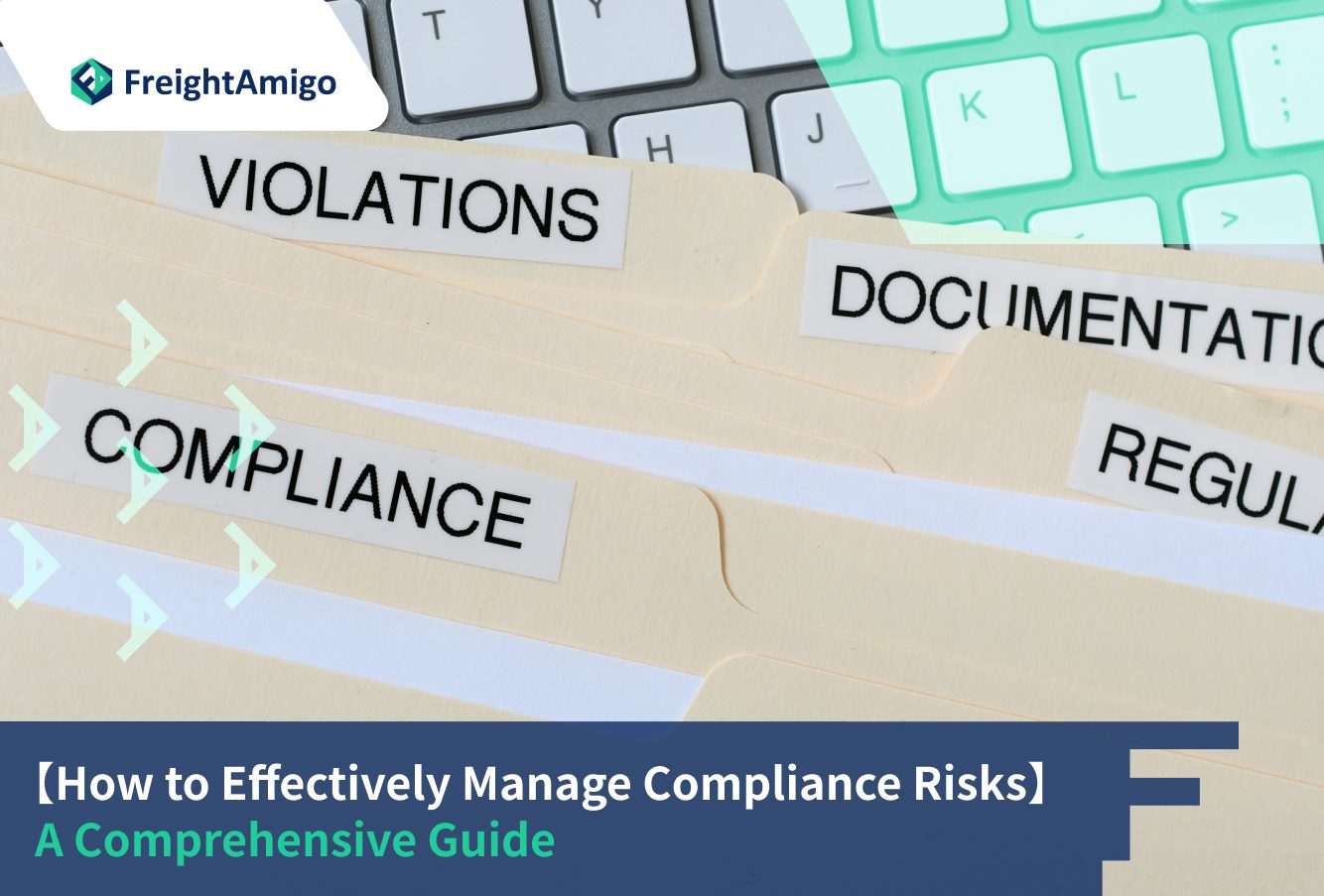Compliance risks can pose significant challenges to businesses, regardless of their size or industry. Failure to comply with industry regulations, laws, and standards can result in financial penalties, reputational damage, and even legal consequences. To avoid these risks and protect your business, it is crucial to have a systematic approach to identifying, mitigating, and managing compliance risks. In this comprehensive guide, we will explore the key steps and strategies for effectively managing compliance risks, ensuring that your business remains compliant and resilient in today’s complex regulatory landscape.
Latest update on 28 February, 2024 by Caspian Ng – Marketing Analyst at FreightAmigo
Want to compare the best Express, Air Freight, Sea Freight, Rail Freight & Trucking rates so as to have better control on cost?
Understanding Compliance Risks
What is Compliance Risk?
Compliance risk, also known as integrity risk, refers to the potential consequences that organizations face when they fail to comply with industry standards, laws, and regulations. These risks can vary depending on the industry and the specific regulations that apply to a business. Compliance risks encompass both financial penalties and reputational damage, making it essential for businesses to prioritize compliance in their operations.
The Impact of Non-Compliance
Non-compliance can have severe consequences for businesses. Apart from the financial impact, such as fines and legal fees, non-compliance can also damage a company’s reputation. Customers and stakeholders may lose trust in the organization, leading to a loss of business opportunities and potential investors. Additionally, non-compliance can result in legal action, which can further harm the company’s finances and long-term viability.
Identifying Applicable Laws and Regulations
Conducting a Compliance Risk Assessment
To effectively manage compliance risks, businesses must first identify all applicable laws, regulations, and standards that impact their operations. Conducting a compliance risk assessment is a crucial step in this process. The assessment involves evaluating the organization’s current compliance practices, identifying potential gaps, and determining the level of risk associated with each compliance requirement.
A comprehensive compliance risk assessment should consider:
- Legal and regulatory requirements specific to the industry
- Contractual obligations with clients, vendors, and partners
- Internal policies and procedures
- Industry best practices and standards
By conducting a thorough risk assessment, businesses can gain a clear understanding of their compliance obligations and prioritize their efforts to address high-risk areas.
Legal, Regulatory, and Contractual Requirements
To ensure compliance, businesses must have a comprehensive understanding of the legal, regulatory, and contractual requirements that apply to their operations. This includes laws and regulations at the local, national, and international levels, industry-specific regulations, and contractual obligations with clients and partners.
Businesses can create a template to identify and document the various legal, regulatory, and contractual requirements that impact their operations. This template serves as a reference guide and helps businesses stay organized and up-to-date with their compliance obligations.
Types of Compliance Risks
Privacy and Data Security
One of the most significant compliance risks facing businesses today is related to privacy and data security. With the increasing volume of data collected and processed by organizations, ensuring the protection of sensitive information has become a critical compliance requirement.
Privacy regulations, such as the General Data Protection Regulation (GDPR) in the European Union and the California Consumer Privacy Act (CCPA) in the United States, impose strict requirements on businesses regarding the collection, storage, and processing of personal data. Failure to comply with these regulations can result in substantial fines and reputational damage.
To mitigate privacy and data security compliance risks, businesses should implement robust data protection measures, including encryption, access controls, and regular security audits. It is also essential to provide privacy training to employees and establish clear policies and procedures for handling personal data.
Workplace Health and Safety
Compliance with workplace health and safety regulations is another critical aspect of managing compliance risks. Failure to provide a safe working environment for employees can lead to accidents, injuries, and legal consequences for businesses.
Regulatory bodies, such as the Occupational Safety and Health Administration (OSHA) in the United States, set specific standards and requirements for workplace safety. These regulations cover various aspects, including hazard communication, employee training, and emergency preparedness.
Businesses must prioritize workplace health and safety by conducting regular risk assessments, implementing safety protocols, and providing ongoing training to employees. It is essential to maintain compliance with applicable health and safety regulations to protect employees and avoid legal liabilities.
Corrupt or Illegal Activities
Compliance risks related to corrupt or illegal activities pose significant challenges to businesses, particularly in industries susceptible to bribery, fraud, or money laundering. Compliance with anti-corruption laws, such as the Foreign Corrupt Practices Act (FCPA) in the United States and the UK Bribery Act, is crucial to prevent legal and reputational damage.
To mitigate compliance risks related to corrupt or illegal activities, businesses must establish robust internal controls, implement anti-corruption policies, and provide regular training to employees. It is also essential to conduct due diligence on business partners and suppliers to ensure they adhere to ethical standards and comply with anti-corruption laws.
Building a Culture of Compliance
Tone at the Top
To effectively manage compliance risks, businesses must establish a culture of compliance that starts with strong leadership and a clear tone at the top. Senior executives and management should demonstrate a commitment to compliance and set an example for employees to follow.
Leadership should communicate the importance of compliance, provide guidance on ethical conduct, and establish policies and procedures that promote compliance throughout the organization. By fostering a culture of compliance, businesses can create an environment where employees understand the expectations and are encouraged to act ethically and within the boundaries of laws and regulations.
Ethics and Compliance Training
Education and training play a crucial role in building a culture of compliance. Businesses should provide regular ethics and compliance training to employees at all levels of the organization. Training programs should cover topics such as anti-corruption, data privacy, workplace safety, and other relevant compliance areas.
Training sessions should be interactive, engaging, and tailored to the specific compliance risks faced by the business. By educating employees about compliance requirements and providing practical guidance on ethical decision-making, businesses can empower their workforce to identify and address compliance risks effectively.
Whistleblower Protection
Encouraging employees to report compliance concerns or potential violations is an essential component of an effective compliance program. Whistleblower protection mechanisms should be in place to ensure that employees feel safe and confident in reporting compliance-related issues without fear of retaliation.
Businesses should establish clear reporting channels, confidential hotlines, or anonymous reporting systems to facilitate the reporting of compliance concerns. It is crucial to communicate the importance of reporting and ensure that employees are aware of their rights and protections as whistleblowers.
Implementing Effective Compliance Controls
Policies and Procedures
Establishing comprehensive policies and procedures is essential for managing compliance risks effectively. These documents provide clear guidelines and expectations for employees, outlining the specific compliance requirements that apply to the business.
Policies and procedures should cover a wide range of compliance areas, including data protection, anti-corruption, workplace safety, and more. They should be regularly reviewed and updated to reflect changes in laws, regulations, or industry standards.
To ensure employee understanding and compliance, businesses should communicate policies and procedures clearly and provide training or resources to support implementation. Regular communication and reinforcement of these policies can help embed a culture of compliance throughout the organization.
Compliance Monitoring and Reporting
To monitor and assess compliance with policies and procedures, businesses should implement a robust compliance monitoring and reporting system. This system allows for the identification of potential compliance issues and the timely resolution of any non-compliance.
Monitoring activities may include regular internal audits, self-assessments, or the use of automated compliance tracking tools. The frequency and scope of monitoring should be based on the level of risk associated with specific compliance requirements.
Reporting mechanisms should be in place to capture and document compliance-related incidents, potential violations, or concerns raised by employees. Timely reporting allows for the investigation and resolution of compliance issues before they escalate.
Automation and Technology Solutions
Leveraging automation and technology solutions can significantly enhance the effectiveness and efficiency of compliance risk management. Automated tools can streamline compliance processes, such as risk assessments, policy management, and compliance monitoring.
Compliance management software can help businesses centralize compliance-related data, automate compliance workflows, and generate real-time reports. These tools can also provide alerts and notifications to ensure timely action and help businesses stay ahead of compliance requirements.
Implementing automation and technology solutions can free up resources, reduce human error, and provide businesses with valuable insights into their compliance performance. It is essential to select the right technology solutions that align with the organization’s specific compliance needs and goals.
Mitigating Compliance Risks through Data Analytics
Using Data for Risk Assessment and Detection
Data analytics can play a crucial role in identifying and assessing compliance risks. By analyzing large volumes of data, businesses can identify patterns, trends, or anomalies that may indicate potential compliance issues.
Data-driven risk assessments can provide valuable insights into areas of high risk and help prioritize compliance efforts. By leveraging advanced analytics techniques, businesses can detect potential compliance violations or fraudulent activities more effectively.
Predictive Analytics and Risk Prevention
Predictive analytics can help businesses anticipate and prevent compliance risks before they occur. By analyzing historical data and identifying risk indicators, businesses can proactively implement controls and measures to mitigate potential compliance risks.
Predictive models can help identify patterns or behaviors that are indicative of non-compliance, enabling businesses to take corrective actions in a timely manner. By leveraging predictive analytics, businesses can shift from reactive compliance management to proactive risk prevention.
Data Visualization for Compliance Reporting
Data visualization tools can enhance compliance reporting and communication. By presenting compliance-related data in a visual format, businesses can quickly understand trends, identify areas of concern, and communicate key compliance metrics to stakeholders.
Dashboards, charts, and graphs can provide a holistic view of compliance performance, allowing businesses to track progress, identify gaps, and make data-driven decisions. Data visualization tools can also facilitate compliance reporting to regulatory bodies, auditors, or internal stakeholders.
The Path to Effective Compliance Risk Management
Managing compliance risks is a multifaceted and ongoing process that requires a systematic approach, strong leadership, and a commitment to continuous improvement. By understanding compliance risks, identifying applicable laws and regulations, building a culture of compliance, implementing effective controls, and staying up-to-date with regulatory changes, businesses can effectively manage compliance risks and protect their operations.
Through the use of data analytics, internal and external audits, and continuous evaluation, businesses can enhance their compliance risk management efforts and demonstrate their commitment to ethical conduct and regulatory compliance.
By following the strategies and best practices outlined in this comprehensive guide, businesses can navigate the complex landscape of compliance risks, protect their reputation, and ensure long-term success in today’s highly regulated business environment.
For efficient manage compliance risks and protect their operations, consult experts like FreightAmigo. Visit the FreightAmigo website to follow the strategies and best practices outlined in comprehensive guide.
Enterprise Credit Risk Management: Beyond Compliance, Towards Business Improvement
Understanding the Importance of ESG Risks in Sustainable Business Practices
Creating a Sustainable Business: The Power of ESG Engagement and Stakeholder Collaboration
If you have any inquiries on logistics/supply chain, feel free to contact FreightAmigo now:
Chat with us online | Hotline: +852 28121686 | WhatsApp: +852 27467829









































